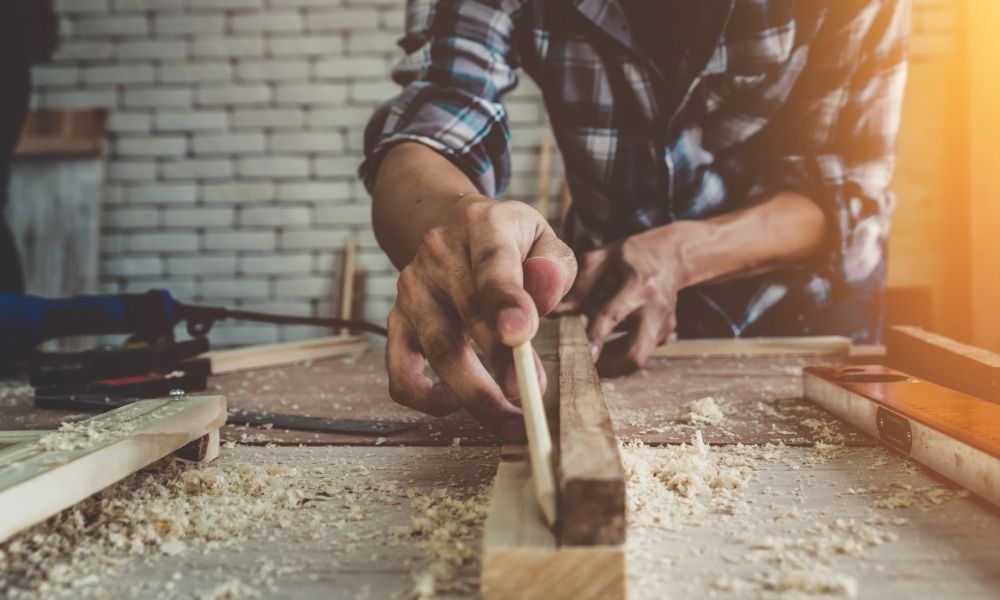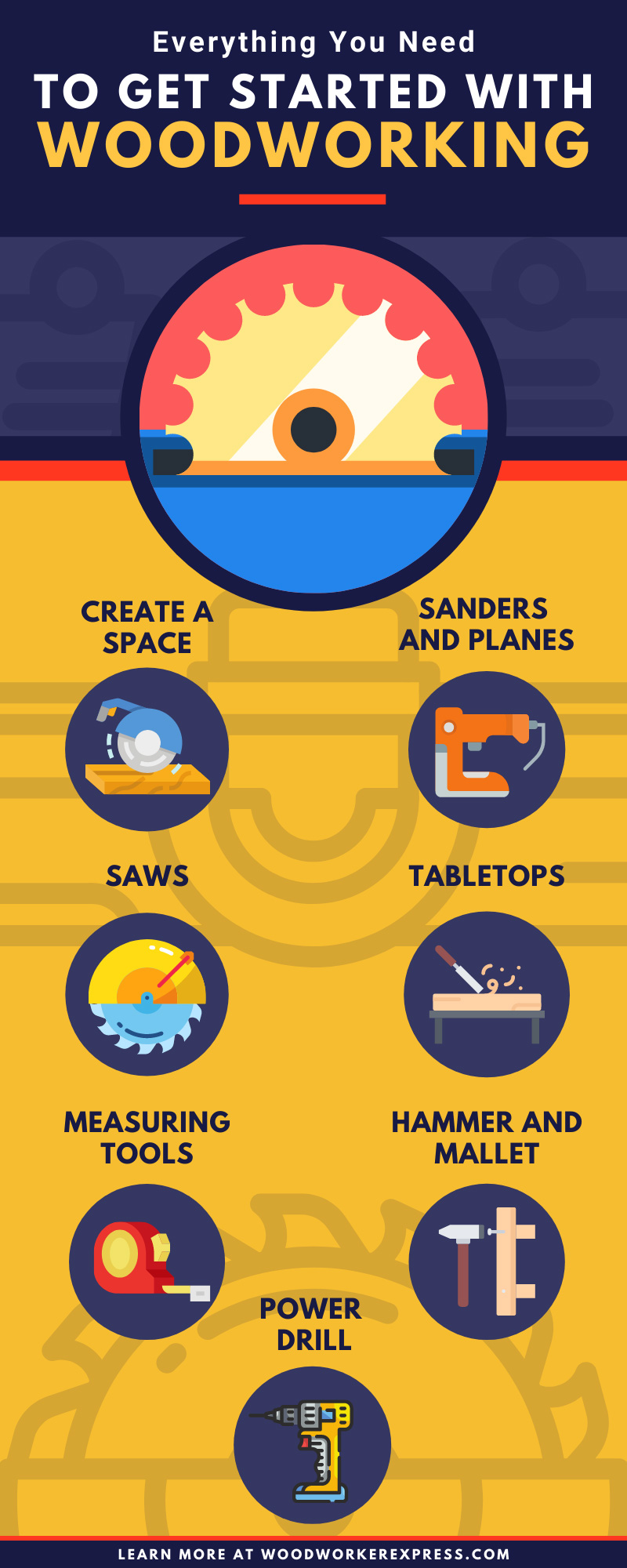
Sometimes getting started is the hardest part when we decide on a new hobby or possibly even a business. Woodworking can be relaxing, and the end results of the creativity and hard work are worth the effort. Let’s discuss everything you need to get started with woodworking.
What Will You Create?
When choosing how to begin woodworking, the first step is having a rough idea of what you will be creating.
This may change with time as you progress and expand, but having a pretty good idea of how large your projects is necessary in deciding on the space and tools you need.
Small accessories, toys, and utensils projects don’t take up much space or require a large saw. However, a dresser or table will.
Create a Space
Hobbies that actually get done are the ones with a designated space for doing so.
Check out your garage and basement for any nook you can find to setup shop. An outdoor shed might also work.
Keep in mind, woodworking creates a lot of dust. It isn’t a hobby you can just quickly work on at the kitchen table (unless you enjoy a dusty dinner). Decide on a space that can handle the mess you are about to make.
Work Surfaces
The next step after finding the perfect space is to create areas where wood can be placed while it is being worked with.
A couple of sawhorses with a sheet of plywood on top will usually do the trick.
A workbench is a must for small projects and intricate detailing. The workbench is a permanent fixture you will find yourself using over and over for more than just woodworking.
Keep tools handy near the work bench and hung on pegboard or placed on shelves above it, for quick and easy fixes.
Saws
Woodworking is not going to happen without a variety of saws to cut the wood. They are quite an investment, but you build your collection over time. Here are five great saws to have in your woodworking toolbox.
Hand Saw
A classic staple for every woodworker, the hand saw will forever be needed. The Hand saw, as its name suggests is a manual tool.
Hand saws take on a few different forms, and each one is designed for quick cuts when there is no need to turn on a power tool.
- Ripping handsaw — cuts lengthwise with the grain
- Crosscut handsaw — cuts across the grain
- Combination handsaws — cuts both with and across the grain
- Backsaw — rectangular blades for miter cuts
- Keyhole handsaw — for interior holes
- Dovetail — for dovetail joint work
Jigsaw
Also recommended for beginners, the jigsaw is a hand-held power tool that can make intricate and curved cuts for beautiful detailing on your wood project.
The jigsaw uses a reciprocating blade to cut irregular curves. A reciprocating blade moves up and down. The jig saw is weak in that the lower end of the blade is unsupported. The user guides the saw to cut but has to be careful not to force the direction of the blade too much.
Circular Saw
The handheld circular saw is a power tool that uses different blades which can be interchanged for different types of cuts. Each blade has different teeth for the type of cuts you are making. It is extremely handy for quick, large cuts.
- Ripping blade — for cutting lengthwise
- Crosscut blade — cut across the grain (width)
- Combination blade — ripping and cutting (both with and against the grain)
Table Saw
As a beginning woodworker, a good larger powered saw to invest in is a table saw. It works similarly to the circular saw, but from a different angle.
Rather than the saw coming down on the wood, the blade from the table saw comes up from the table and the wood is placed on top of it. This eliminates a lot of work and makes long precision cuts a bit easier.
Table saws offer different types of blades for different cuts.
They also can be portable or permanent.
- Benchtop table saw — Noisiest of all the benchtop table saws, but lightweight, compact and portable.
- Cabinet table saw — Heavy and made to stay put, they can handle every project. These make a stately centerpiece to your woodworking shop.
Band Saw
A band saw is a power tool, perfect for intricate, curvy woodworking cuts. It consists of a continuous band of toothed metal stretched between two or more wheels to cut material.
Unlike the jigsaw where you guide the saw to cut the wood, a band saw stands stationary and a wood piece is guided against the cutting blade to make the cuts.
They come in a few sizes and make a great addition when it is time to get detailed beyond using a jigsaw.
Sanding
Filing, sanding, and planes all fall under the same category: to smooth or shape the wood for woodworking projects. There are a few different options for each.
Filing
Files are hand tools used for smoothing and are made of metal, giving them a longer life than sandpaper.
Once dull, they don’t sharpen well, so it is best to replace them.
Sanding
Handheld electric sanders are a time saver and a hand saver. A lot of sanding makes a hand sore.
They come in different sizes and power and can alternate between different grades of sandpaper.
Sanding sponges and sandpaper are necessary to have on hand for quick, small projects or intricate details.
Planes
Planes don’t just smooth the wood, but they actually remove some of the wood by scraping pieces off. It is more of a shaving process than a smoothing one as the blade on the plane shaves thin slices off the surface of the wood.
There are several different types of planes.
- Jack plane — removes a lot of wood at once
- Block — for intricate, small spaces
- Rabbet — for right angle grooves
- Scraper — finely scrapes for smooth finishes
- Spokeshaves — designed for curves
Measuring Tools
Please don’t “wing it” with woodworking. Taking the time to measure properly from the beginning saves you time from having to fix mistakes later.
There are four measuring tools to keep handy while woodworking. These include:
- Retractable steel tape measure — handy in every way with the stiffness of steel and a hook on the end for easy measuring
- Yard stick — great for straight edge measuring and line drawing with a pencil
- Flexible reel tape — a must when a bendable measure for corners and curves is needed
- Folding measure — highly accurate and stiff like a yard stick, these fold into multiple sections for easy storage
Hammer and Mallet
A basic hammer has a double-duty steel head with one end basically designed for hammering in nails and the other for pulling them out. A hammer should be a standard tool in everyone’s home, not only woodworkers.
A mallet is different than a hammer, although they are both used for striking. Rather than a steel head, the head is rubber, leather, or wood. The head is sometimes detachable to accommodate multiple sizes.
A mallet is used when a hard strike is needed but damage needs to be prevented. That is why they are made with a softer material head. The shock to the wood is softer than a steel head hammer.
Power Drill
A power drill will become your right-hand man in woodworking, for drilling quick holes and driving screws.
This is a general idea of everything you need to get started with woodworking. Build your collection slowly and enjoy creating heirlooms you can be proud of.
Woodworker Express offers woodworking tools for sale to provide you with everything you need to get your woodworking shop up and running.













 Do Not Sell My Personal Information
Do Not Sell My Personal Information